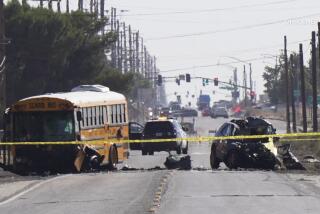Orange County Faulted in Study of School Zones
- Share via
WASHINGTON — When it comes to driving responsibly in school zones, motorists around the country “failed miserably”--and Orange County drivers were among the worst offenders--according to a survey scheduled for release today.
While 65% of drivers nationwide go 5 mph or more over the posted limit in school zones, 87% of those in Orange County speed near schools, said the survey by the National Safe Kids Campaign, a child- safety advocacy group.
The survey, which used local police to clock vehicle speeds during the half-hour before and after school in 29 regions around the country, was the first of its kind. But the danger to children from moving vehicles has been well documented.
According to the National Highway Traffic Safety Administration, car crashes involving child pedestrians are the second-leading cause of death for children ages 5 to 14. Each year, an average of 675 children die of motor vehicle-related pedestrian injuries and an additional 20,000 are injured.
Young children may be particularly vulnerable to injury and death in such accidents because their auditory and visual capabilities are not fully developed until age 10, according to studies cited in the survey. As a result, they may have difficulty judging the speed and distance of an oncoming vehicle.
The release of the survey coincides with Walk Our Children to School Day, in which volunteers in 39 cities in California and across the nation will accompany children as they walk to school today--offering safety tips and alerting them to potential hazards along the way.
The speed limit in most school zones is 25 mph. Although most Orange County drivers in the survey averaged about 7 mph over the speed limit, 31% were traveling at least 10 mph over the limit, the survey found.
Even a slight increase over the speed limit has a significant effect on children’s safety, according to the survey. The risk of a child pedestrian being killed in a vehicle-related accident is eight times greater by a car traveling 30 mph than one going 20 mph.
“Speeding in school zones has always been a problem here,” said Officer Dick Worcester of the Irvine Police Department. “But on a local basis, within the last year or two, speeding [in school zones] has gotten significantly worse. Harried schedules seem to be across the board. Everyone is trying to make up a little time, and they are doing it by stepping on the accelerator.”
Worcester said it often is parents themselves who endanger children’s safety. “We often pull over parents for speeding as they rush their child to school before they go off to their own workday,” he said. “They are focused on the safety of their own child, but they are often not so concerned about other children.”
More to Read
Sign up for Essential California
The most important California stories and recommendations in your inbox every morning.
You may occasionally receive promotional content from the Los Angeles Times.













